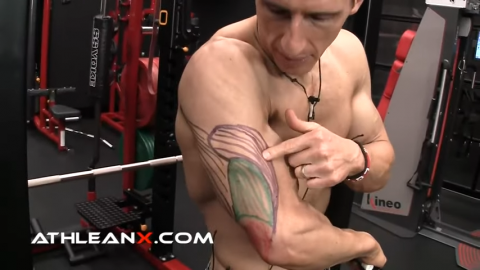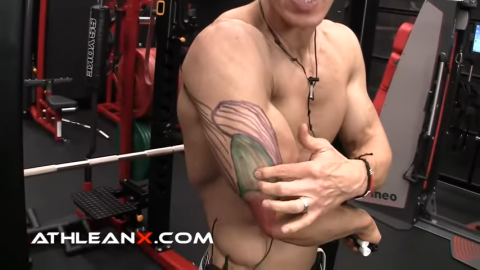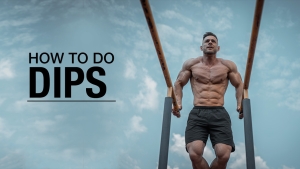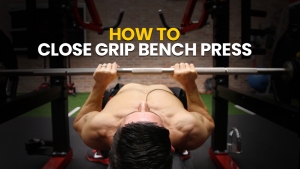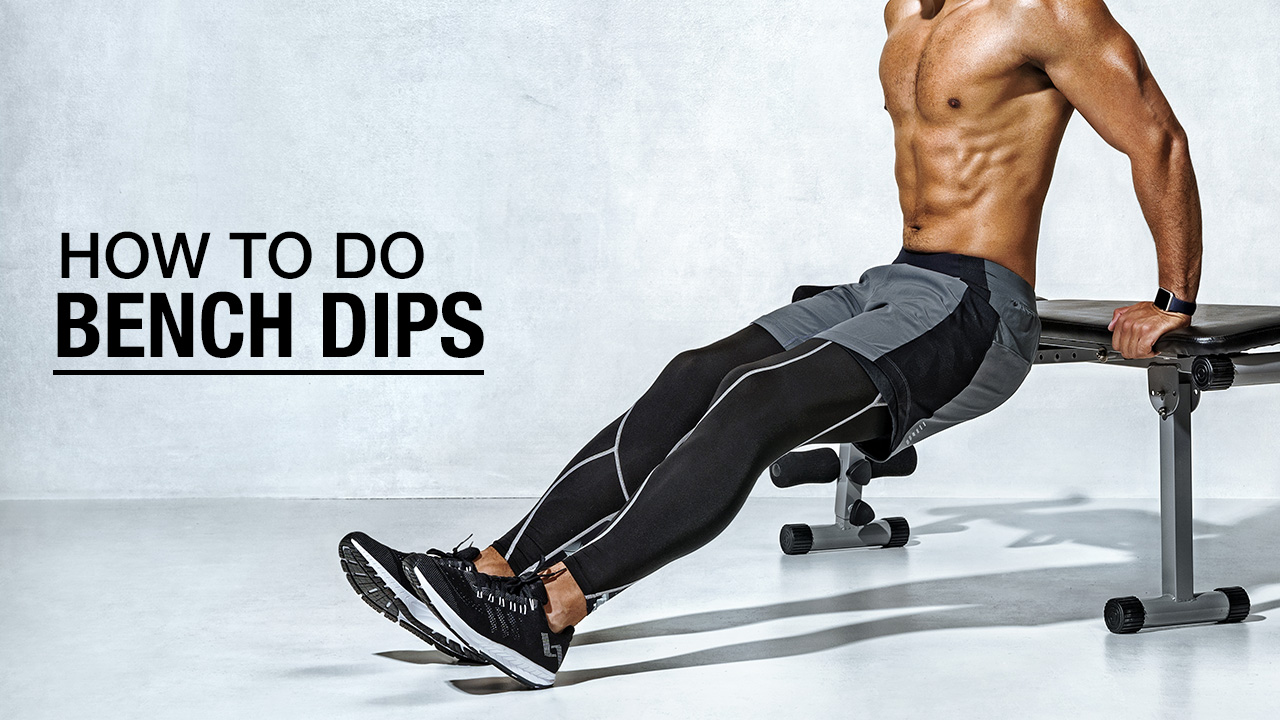
ARE YOU DOING BENCH DIPS CORRECTLY?
Let’s talk about Bench Dips and why they might be wrecking your shoulders instead of building up your triceps.
The so-called tried-and-true triceps exercise known as the Bench Dip is often more of a shoulder shredder than a triceps builder, and there’s a good reason for it.
When done with poor form or in the wrong position, this simple bodyweight exercise can lead to shoulder pain and long-term issues like impingement.
But Bench Dips don’t have to be dangerous if you follow the right cues and maintain proper form.
I’ll show you how to execute bodyweight Bench Dips correctly, protecting your shoulders while still hitting the triceps muscle effectively.
Whether you’re using an elevated surface like a bench or practicing floor dips, you’ll need to master shoulder mobility and the right angles to keep your joints safe and your gains consistent.
By the end of this post, you’ll not only know how to avoid the “rotator cuff ripper-dip” but also how to up your triceps training exercises with bench dip variations that actually work.
BENCH DIPS: MUSCLES WORKED
When it comes to Bench Dip exercises, simply going through the motions won’t get you the results you’re after.
To fully engage the triceps and supporting muscles, you need to dial in your mind-to-muscle connection.
Just like when performing a Bicep Curl, where you focus on squeezing the biceps with every rep, the same principle applies to Bench Dips.
By actively engaging the triceps muscles, deltoid muscles, and pec muscles during each portion of the exercise, you ensure you’re hitting the target muscles and avoiding unnecessary strain on your joints.
Whether you’re a fitness trainer guiding clients or simply fine-tuning your own upper body workout, understanding how to control every muscle involved is key to mastering this movement.
Proper hand positioning on the edge of bench, shoulder stability, and controlling your body weight are essential for both building strength and keeping your shoulders healthy.
TRICEPS
The triceps, the primary muscle activated during bench dips and the biggest muscle in the arms, play a crucial role in extending the elbow and stabilizing the upper body.
This makes Bench Dips essential for building upper body strength while fitting seamlessly into any comprehensive exercise program. This is because they also target the deltoids and pec muscles while promoting healthy shoulder function through proper hand positioning and external shoulder rotation.
LATERAL HEAD
When it comes to the lateral head of the triceps—the part that really adds width and definition to your upper arm—it’s extremely important for building that strong, sculpted look.
Located on the outer part of the upper arm, this muscle is crucial for pushing power and upper body strength.
The lateral head is all about elbow extension, which is key in exercises like Triceps Bench Dips, Pushdowns, and various press movements.
But here’s the thing: if you want to really hit this muscle, your form needs to be dialed in—especially with your shoulder position.
For the Bench Dip, keeping your hands shoulder-width apart and your shoulder externally rotated is critical for engaging the lateral head while maintaining healthy shoulder function.
This ensures the stabilizer muscles do their job without putting unnecessary strain on the shoulder joint.
To maximize activation, use complementary exercises like Close-Grip Push-Ups, Triceps Extensions (Skull Crushers), and Floor Dip variations.
Make sure your starting position and equipment angle are spot on, whether you’re practicing Floor Dips with your legs extended or adjusting your level of strength on an exercise mat.
MEDIAL HEAD
When it comes to the medial head of the triceps, this muscle is crucial for strength and endurance.
Located on the inner part of your upper arm, it’s a key player in elbow extension and helps lock in that full range of motion during exercises like Triceps Bench Dips.
The medial head is all about maintaining proper form and keeping your joints safe, especially when your elbows are at that critical point in the dip.
If you want to really target the medial head and build a solid foundation for your upper body, focus on keeping your body at the right shoulder height while performing dips, ensuring that your elbows extend fully at the bottom portion of the exercise.
Whether you’re working with a personal trainer or following suggestions from comprehensive exercise libraries, dialing in this exact level of strength and form is key to getting your body into shape without risking injury.
LONG HEAD
The long head of the triceps is important for your arm’s overall size and strength.
This part of the muscle not only handles elbow extension but also shoulder extension—key for movements like Triceps Bench Dips and Overhead Tricep Extensions.
Because the long head attaches at the shoulder, it’s heavily involved when you’re pushing your arm back or straightening it under load, which is why it’s a primary player in dips.
To effectively target the long head, you need a mix of bodyweight and weighted exercises. Triceps Bench Dips are perfect for hitting this muscle when combined with other movements like Pull-Ups, Overhead Extensions, and Close-Grip Bench Presses.
Pay close attention to the portion of the exercise where your elbows are fully bent, and the shoulders are in extension—this is where the long head does the heavy lifting.
BENCH DIPS: WHAT DO MOST PEOPLE DO WRONG?
What’s the problem with how most people do Bench Dips?
A lot of people might say, “But Jeff, the way you’re doing this simple exercise (in the video below) looks normal.”
This is exactly the shoulder risk issue I’m talking about.
What seems ‘normal’ in this exercise is what’s wrecking your shoulders.
Let me show you what I’m talking about:

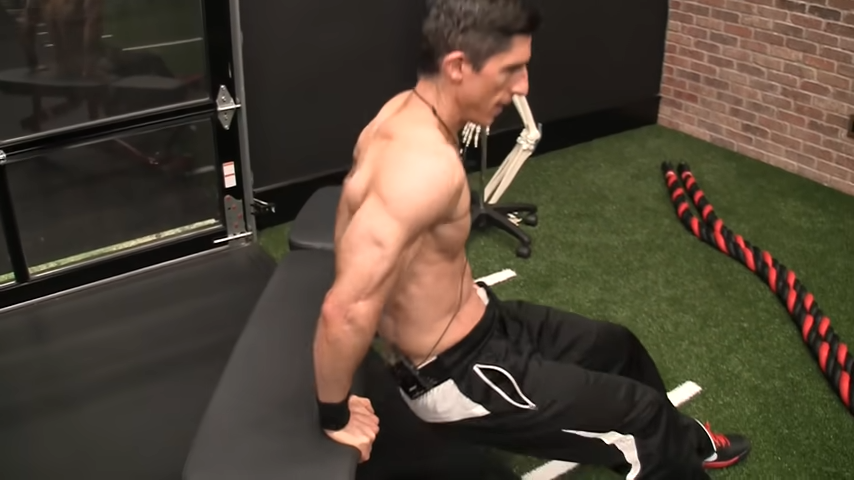
When you perform bench dips with poor form, the first thing you’ll notice is how your shoulder position is all wrong.
Instead of keeping the shoulder blades back and down, people let them collapse forward, hiking up towards their ears as they crank out reps.
This dangerous position forces the shoulder joint into a compressed and awkward angle that’s bound to cause injury.
This can cause huge issues if you have a preexisting shoulder injury.
Your supraspinatus tendon, rotator cuff, and bursae get jammed up and squeezed with every rep, leading to inflammation, shoulder pain, and eventually, shoulder impingement.
Now, if you look at what’s happening inside the shoulder joint during these faulty dips, you’ll see that as soon as you press your bodyweight upward, your arm is positioned behind your body, causing compression in the joint.
But when you let your shoulder blades drift forward and lose that 90-degree angle, you’re forcing everything to grind against limited space—especially at the lowest position of the dip. Over time, this repetitive stress is a fast track to shoulder issues.
If you’re serious about training and want to avoid this, you need to focus on proper shoulder mobility and alignment.
Whether you’re doing Bench Dips, Floor Dips, or other bodyweight triceps exercises, you have to control the position of your shoulder blades and maintain a proper range of motion.
By fixing your form cues, you can target the triceps muscle effectively without sacrificing your shoulder health.
Trust me, a reliable movement pattern with proper exercise technique is the difference between safe triceps training and a trip to the doctor.
HOW TO DO BENCH DIPS
Bench Dips are a staple triceps exercise, but most people mess them up and end up trashing their shoulders instead of building muscle.
If you’ve ever felt shoulder pain doing dips, it’s probably because you’re making some common mistakes that put your joints at serious risk.
I’m going to show you the right way to perform bench dips, focusing on shoulder stability, proper form, and making sure the triceps—not your joints—take the heat.
Let’s break down the Bench Dip movement pattern.
EXTERNALLY ROTATE THE SHOULDER

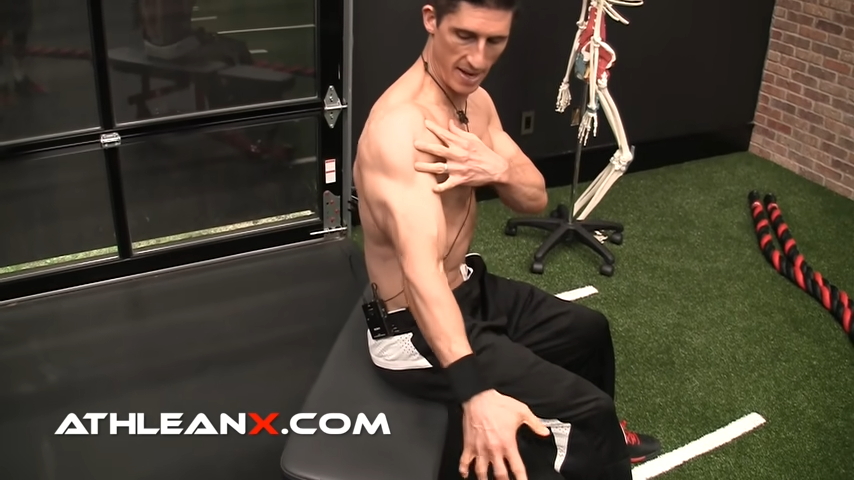
The first thing you have to do is externally rotate the shoulder because internal rotation is going to pull the shoulder forward.
External rotation is going to pull the shoulder back.
POSITION YOUR HANDS


Most people take their thumbs, and they put them right next to their body.
When they do this, they are internally rotating, and this means there’s no chance they’re doing the exercise properly.
If you take my hands and turn them out, now you’re externally rotating. You can see the position of the shoulder as I turn out: it goes back, which is what you want.
DON’T LET YOUR SHOULDERS COLLAPSE


Another big mistake? Letting your shoulders collapse into your neck and forward.
Once that happens, your shoulder gets shoved out of position, and you’re setting yourself up for injury.
Here’s what you should be doing instead: shoulders down and back.
From a side view, notice the difference.
If you let your shoulders collapse forward and hike up while you dip, your form is compromised, and your shoulder joint is in a bad position.
But if you actively pull those shoulder blades back and down, you’re keeping the joint stable and forcing your triceps to do the work they’re supposed to be doing.
It might feel tougher, but that’s exactly the point.
When you keep your shoulders locked down and let your elbows bend, you’re shifting the load where it belongs—on the triceps muscle.
This not only maximizes the effectiveness of the exercise but also keeps your shoulders safe.
So, next time you hit those dips, focus on keeping your shoulders in a strong, stable position and let your triceps handle the load.
BENCH DIPS

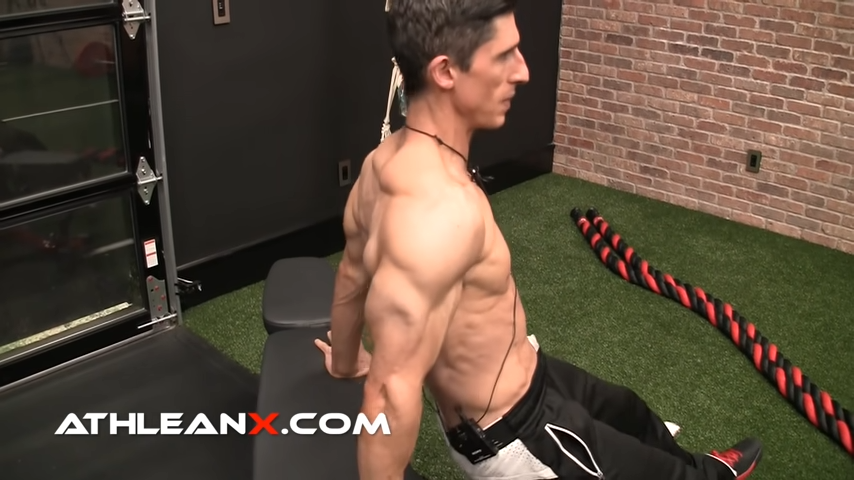
HOW TO DO THE BENCH DIP
- Sitting on a flat bench, turn your hands slightly outward when placing your hands on edge of bench. This simple adjustment keeps your shoulders in a more stable position, pulling them back where they should be.
- Before you even start the dip movement, make sure to externally rotate your shoulders. This is crucial because internal rotation pulls your shoulders forward, putting you at risk for shoulder impingement.
- Actively retract and depress your shoulder blades—think about pulling them down and back. This keeps your upper body stable and allows your triceps muscle to do the heavy lifting.
- As you lower into the dip, maintain a 90-degree angle at the elbow while keeping your shoulders locked in place. This not only targets the triceps more effectively but also avoids unnecessary strain on the shoulder joint.
- Your movement should be controlled, with a focus on the upward movement as you press back up. Keep your body in line, with your heels on floor or your feet elevated on a surface, depending on your fitness level.
WHAT MAKES IT EFFECTIVE: This bodyweight exercise is simple but effective when done correctly and can be scaled with advanced variations like elevating your feet or adding weight.
BENCH DIPS: COMMON MISTAKES
Bench Dips are an effective triceps exercise, but they’re also easy to mess up, which can lead to injury and poor results.
Here’s a closer look at the most common mistakes and how to correct them:
SHOULDER COLLAPSE
One of the most dangerous mistakes during bench dips is letting your shoulders collapse forward.
When your shoulders shrug up towards your ears, you’re creating instability in the shoulder joint, which can lead to shoulder impingement or even rotator cuff injuries.
This happens because the shoulder blades are not properly retracted and depressed, which is necessary for maintaining a strong, stable position.
The correct technique involves actively pulling your shoulder blades down and back throughout the entire range of motion.
Not only does this improve your shoulder health, but it also maximizes triceps activation, allowing you to focus on the muscle rather than the joint.
If you struggle with this, practicing on the floor with legs extended and concentrating on shoulder stability can help build the right habit.
INCORRECT HAND POSITIONING
Another common issue is placing your hands too close to your body on the bench.
This leads to internal shoulder rotation, which puts unnecessary strain on the shoulder joint and can cause discomfort or injury.
Ideally, your hands should be positioned slightly wider than your hips, with a slight outward rotation.
This adjustment externally rotates the shoulders, keeping them in a safer and more stable position.
It also aligns the triceps better for optimal engagement during the movement.
Proper hand positioning isn’t just for injury prevention—it’s essential for getting the most out of this portion of exercise.
IMPROPER ELBOW ALIGNMENT
Elbow positioning is critical in bench dips.
A common mistake is allowing your elbows to flare out to the sides or not bending them to a proper 90-degree angle.
When the elbows flare out, you reduce the effectiveness of the triceps activation and shift the tension to the shoulders, increasing the risk of injury.
Additionally, failing to reach a 90-degree angle shortchanges the exercise by limiting the range of motion and muscle engagement.
To correct this, keep your elbows tucked close to your body and focus on achieving that 90-degree bend at the bottom of the dip.
If you’re unsure of your form, practicing with a fitness trainer or referring to a resource for exercise professionals can provide valuable feedback.
OVEREXTENDING AT THE BOTTOM
Many people think dropping as low as possible in the dip will give them better results, but overextending at the bottom of the movement is a major mistake.
Going too low places excessive strain on the shoulder joint, particularly when your arms move beyond their natural range of motion.
Instead, aim to stop when your upper arms are parallel to the floor.
This ensures you stay within a safe range of motion while still getting the full benefits of the exercise.
Practicing with Floor Dips, where your legs are extended and your range of motion is more controlled, can help you learn how to maintain the correct depth without overextending.
NEGLECTING BODY CONTROL
Using momentum to swing through reps is another common error.
When you rely on momentum instead of muscle control, you shift the focus away from the triceps and involve other muscles that shouldn’t be dominating the movement.
This not only reduces the effectiveness of the exercise but also increases the risk of injury due to unstable body positioning.
Instead, focus on controlling every portion of the exercise—from the lowering phase to the press back up.
Each rep should be smooth and controlled, with minimal movement in the torso or legs.
Maintaining control builds better muscle engagement and safer execution.
For those just starting out or working at a lower fitness level, practicing the bench dip movement pattern under controlled conditions, like using an exercise mat for extra stability, can reinforce proper technique.
Mastering the triceps Bench Dip comes down to understanding proper form and avoiding common mistakes that can lead to injury.
By focusing on shoulder stability, correct hand positioning, and controlled movement, you can safely maximize triceps activation and upper body strength.
Keep these tips in mind during your next workout, and you’ll turn the Bench Dip into a reliable, results-driven exercise that supports your overall fitness goals.
If you’re looking for a training program that covers every muscle in the body, we’ve got you covered. Check out our ATHLEAN-X programs to see which is the best fit for your goals and fitness level.

- Bench Dips are a highly effective bodyweight exercise for building triceps strength and size, making them a go-to move in upper body workouts.
- The problem is, most people mess them up by letting their shoulders collapse forward, using poor elbow positioning, and relying on momentum instead of muscle control—all of which can lead to shoulder pain and take the focus off the triceps.
- Here’s how to perform Bench Dips with correct form:
- When setting up, don’t just slap your hands on the bench. Turn them slightly outward to instantly improve shoulder stability. This minor tweak shifts your shoulders back, locking them into a safer, stronger position.
- Before dropping into the dip, make sure your shoulders are externally rotated. Internal rotation is a fast track to shoulder impingement—keep those shoulders rotated back to protect your joints.
- Pull your shoulder blades down and back like you’re squeezing them into your back pockets. This keeps your upper body stable and forces the triceps to carry the load—right where you want the tension.
- As you lower into the dip, hit that 90-degree bend in your elbows. This angle optimizes triceps activation while keeping the shoulders out of harm’s way. The key is to maintain locked shoulders throughout.
- Don’t rush the rep. Control the entire motion, especially the press back up. Keep your body aligned, with either your heels on the floor or feet elevated depending on your fitness level. Smooth, controlled reps are what build strength, not bouncing through the movement.
BENCH DIPS FAQ
Bench Dips are a killer exercise for hitting the triceps—specifically all three heads: the long, lateral, and medial.
But they’re not just a one-trick pony.
Done right, they also engage your chest (pecs), front shoulders (anterior delts), and even the stabilizer muscles in your core.
The key is maintaining good form—keeping your shoulders back and down, elbows tight, and focusing on full triceps extension.
Skip the sloppy reps that crank your shoulders forward, or you’ll end up working on shoulder pain more than muscle gain.
Want to round out your routine?
Pair them with exercises like Crab Walk exercises or Curl Biceps for a balanced upper body workout that covers all the bases.
Absolutely, but only if you do them right.
Bench Dips can be a solid mass-builder for your triceps—especially when you focus on proper form and progressive overload.
The trick is to avoid the common mistakes that turn this into a shoulder-wrecker instead of a muscle-builder.
Keep your shoulders down and back, elbows tight, and control every rep.
If you want to maximize gains, start with Bodyweight Dips, and then level up by adding resistance, like a weight plate on your lap.
Combine them with other mass-builders like Close-Grip Push-Ups or Curl Biceps, and you’ve got a recipe for real triceps growth.
It’s not about the number of bench dips you crank out—it’s about doing them right.
Quality over quantity.
If you’re banging out high reps with bad form, you’re just setting yourself up for shoulder pain, not muscle gains.
Instead, aim for 3-4 sets of 8-15 reps, focusing on perfect form every time.
Keep your shoulders back, elbows tight, and control the entire movement.
Bench Dips can be a shoulder nightmare if you’re not careful.
The problem is that most people let their shoulders collapse forward, putting them in a dangerous position that grinds up the joint and leads to impingement or injury.
On top of that, if you’re cranking out dips with poor shoulder and elbow alignment, you’re shifting the load away from the triceps and onto your rotator cuff—a recipe for disaster.
If you’ve got preexisting shoulder issues or poor shoulder mobility, you might want to skip traditional Bench Dips altogether.
There are safer alternatives, like Floor Dips or Parallel Bar Dips, that give you the same triceps activation without the shoulder risk.
REFERENCES

Jeff Cavaliere M.S.P.T, CSCS
Jeff Cavaliere is a Physical Therapist, Strength Coach and creator of the ATHLEAN-X Training Programs and ATHLEAN-Rx Supplements. He has a Masters in Physical Therapy (MSPT) and has worked as Head Physical Therapist for the New York Mets, as well as training many elite professional athletes in Major League Baseball, NFL, MMA and professional wrestling. His programs produce “next level” achievements in muscle size, strength and performance for professional athletes and anyone looking to build a muscular athletic physique.

















